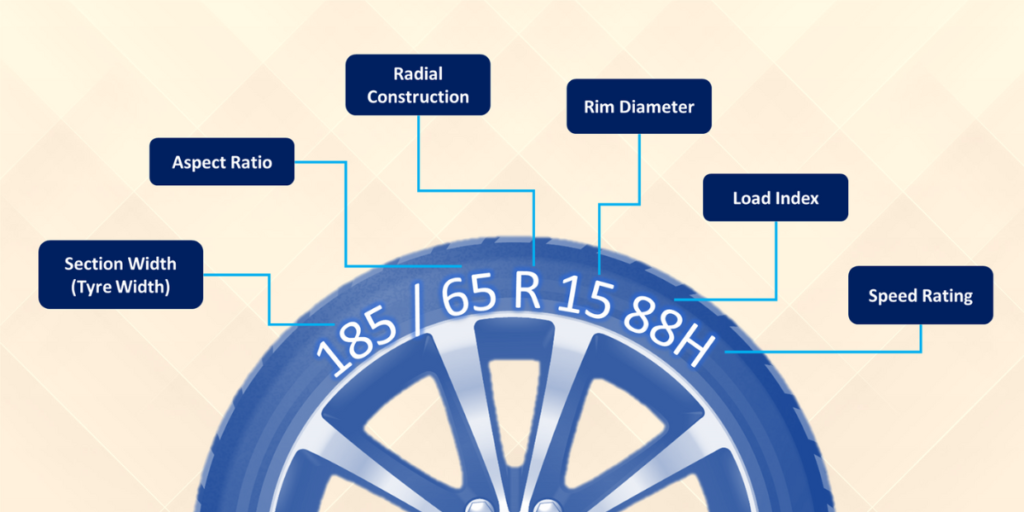Choosing the right tyre size for your vehicle isn’t just about fitting the wheels; it’s about ensuring the best performance, safety, and efficiency on the road. In India, where vehicles range from bicycles to commercial trucks and tractors, knowing your tyre size helps you navigate the diverse road conditions and meet the specific needs of your vehicle.
This guide breaks down standard tyre sizes for various vehicles, from cars and bicycles to heavy trucks and agricultural tractors. We’ll cover how to read tyre labels, which standards to follow, and provide tables for each vehicle category to simplify the tyre selection process.
Table of Contents
What is Tyre Size?
The term tyre size refers to a set of measurements that define a tyre’s dimensions, including its width, height (aspect ratio), and the diameter of the wheel (rim) it fits. Choosing the correct size ensures optimal vehicle performance, improved safety, and better fuel efficiency. For Indian drivers, selecting the right tyre is especially important given the country’s varying road conditions.
How to Read a Tyre Size Label
Tyre labels are written on the sidewall of every tyre in a standard format like 185/65 R15 88H. Here’s how to read this code:
- 185: The width of the tyre in millimeters.
- 65: The aspect ratio, which is the height of the tyre’s sidewall as a percentage of its width. In this case, it’s 65% of 185 mm.
- R: Denotes a radial tyre, the most common type today.
- 15: The diameter of the wheel rim in inches.
- 88: The load index, representing how much weight the tyre can safely carry.
- H: The speed rating, which indicates the maximum speed the tyre can handle.
Understanding these elements helps you select the correct tyre for your vehicle, ensuring a smooth and safe ride.

Tyre Size Standards (Indian and International)
In India, tyres are regulated by the Bureau of Indian Standards (BIS) to ensure safety and performance on Indian roads. Some key standards include:
- IS 15627:2005: Governs the specifications for automotive tyres, including radial and bias-ply types.
- ISO 4000: An international standard for passenger car tyres.
- ETRTO (European Tyre and Rim Technical Organization): Provides guidelines for sizes, especially for commercial and agricultural vehicles.
Common Tyre Sizes for Cars
In India, cars are categorized into different segments like hatchbacks, sedans, and SUVs, each requiring specific tyre sizes. Here’s a look at common tyre for cars:
| Car Type | Common Sizes (mm) | Rim Diameter (inches) |
|---|---|---|
| Hatchback | 155/65 R13, 165/80 R14, 175/65 R15 | 13, 14, 15 |
| Sedan | 185/65 R15, 195/60 R16, 205/55 R16 | 15, 16 |
| SUV | 215/65 R16, 235/55 R18, 265/65 R17 | 16, 17, 18 |
| Luxury Car | 245/45 R18, 255/40 R19, 275/35 R20 | 18, 19, 20 |
Key Considerations
- Hatchbacks: Often come with smaller tyres for better fuel efficiency and handling.
- SUVs: Use larger tyres designed for off-road and all-terrain driving.
- Luxury Cars: Have wider tyres for enhanced performance and handling.
Common Tyre Sizes for Motorcycles
Motorcycles require tyres that offer good grip, stability, and durability, especially for Indian roads where both urban and rural conditions can be quite different. The table below lists standard sizes for various types of motorcycles in India:
| Motorcycle Type | Common Sizes (inches/mm) | Rim Diameter (inches) |
|---|---|---|
| Commuter Bike | 80/100-18, 90/90-18, 100/90-17 | 17, 18 |
| Sports Bike | 110/70 R17, 120/70 R17, 150/60 R17 | 17 |
| Cruiser Bike | 90/90-19, 150/80 R16, 180/70 R16 | 16, 19 |
| Off-Road Bike | 90/90-21, 120/80-18 | 18, 21 |
Points to Remember
- Commuter Bikes: Prioritize fuel efficiency and durability with smaller tyres.
- Sports Bikes: Use wider tyres for high-speed stability and cornering.
- Cruisers: Need larger rear tyres for comfort and smooth rides over long distances.
- Off-Road Bikes: Require thick tyres for better traction on dirt and uneven terrains.
Common Tyre Sizes for Bicycles
Bicycle tyres vary greatly depending on the type of cycling—road, mountain, or commuting. Below are the standard tyre sizes used in India:
| Bicycle Type | Common Sizes (inches/mm) |
|---|---|
| Road Bike | 700x23c, 700x25c, 700x28c |
| Mountain Bike | 26×1.95, 27.5×2.1, 29×2.2 |
| Commuter/Hybrid Bike | 700x35c, 700x38c, 650x47c |
| BMX Bike | 20×1.75, 20×2.1 |
Key Points
- Road Bikes: Opt for narrower tyres for lower rolling resistance.
- Mountain Bikes: Require wider, grippier tyres for off-road trails.
- Commuter Bikes: Offer more comfort and durability for daily use.
- BMX: Use smaller, sturdier tyres for stunts and tricks.
Common Tyre Sizes for Commercial Vehicles (Light and Heavy)
Tyres for commercial vehicles are built to carry heavy loads and withstand long distances on rough terrains. Here’s a look at common tyre for light and heavy commercial vehicles:
| Vehicle Type | Common Sizes (mm) | Rim Diameter (inches) |
|---|---|---|
| Light Commercial Vehicles (LCV) | 195/75 R16, 215/75 R16, 225/75 R16 | 16 |
| Heavy Commercial Vehicles (HCV) | 10.00 R20, 11.00 R20, 295/80 R22.5 | 20, 22.5 |
| Bus | 235/75 R17.5, 275/70 R22.5 | 17.5, 22.5 |
Important Considerations
- LCVs: Designed for city use, these tyres are smaller but robust.
- HCVs: Larger tyres are needed for long-haul heavy-duty transport.
- Buses: Use tyres that balance passenger comfort with long-lasting durability.
Common Tyre Sizes for Tractors
Tractor tyres are specialised for off-road, agricultural use, providing the necessary traction and load-bearing ability. The table below lists common tractor tyre in India:
| Tractor Tyre Position | Common Tyre Sizes (inches) |
|---|---|
| Front Tyres | 6.00-16, 7.50-16, 9.00-16 |
| Rear Tyres | 12.4-28, 13.6-28, 14.9-28 |
Key Notes
- Front Tyres: Smaller to enable easier steering.
- Rear Tyres: Larger for higher traction and better torque in agricultural fields.
Conclusion
Understanding sizes and choosing the right one for your vehicle can significantly enhance your driving experience, safety, and vehicle performance. From motorcycles and bicycles to cars and heavy commercial vehicles, each vehicle requires specific tyre sizes to handle the unique demands of Indian roads.
By referring to the right tyre size for your vehicle and adhering to standards like BIS IS 15627 and ISO 4000, you can ensure that your vehicle runs efficiently and safely. So, next time you’re in the market for new tyres, be sure to select the correct size to keep your vehicle performing at its best!


